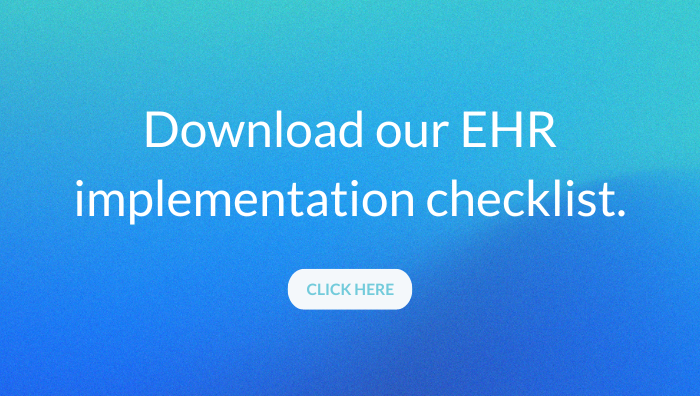Welcome to the essential manual tailored specifically for CIOs and CTOs leading their healthcare organizations through the complex journey of migrating data to Oracle Health Electronic Health Records (EHR). You’re on the verge of a pivotal shift that will enhance the efficiency, security, and quality of patient care at your institution. This guide serves as your lighthouse, illuminating the way through the data migration process and ensuring a seamless transition in line with your strategic goals.
Looking for the IT manager guide? Click here.
Let’s get started.
Understanding the basics of data migration
At its core, data migration involves transferring data from one system to another— in this context, from an existing EHR platform to Oracle Health EHR. This process is not just a technical task but a pivotal step toward realizing the full potential of digital health records in improving patient care, operational efficiency, and compliance with regulatory standards. The challenges specific to EHR platforms, such as data volume, complexity, and the need for data integrity, make this task particularly demanding.
Expected timings for data migration to Oracle Health EHR
The timeline for migrating to Oracle Health EHR from another electronic health records system can significantly vary depending on several critical factors.
Typically, the migration process might take anywhere from six months to over a year. This broad timeframe accounts for the initial planning stages, data preparation, the actual migration, testing, and the transition to go-live. The speed and efficiency of the migration are influenced by several key factors:
Complexity and volume of existing data
Larger datasets with complex structures require more time to migrate accurately. Ensuring data integrity and minimizing loss during this process are paramount, often requiring meticulous planning and execution.
Preparation and cleanup of data
The extent of data cleansing and preparation before migration can significantly impact the timeline. Clean, well-organized data can be migrated more swiftly and with fewer issues.
Integration requirements
The number and complexity of integrations with other systems and applications can extend the timeline. Custom integrations, in particular, require careful planning, development, and testing.
Staff training and change management
Adequate time must be allocated for training the staff on the new EHR system and managing the change process within the organization. The faster staff can adapt, the smoother the transition phase will be.
Technical infrastructure and support
The presence of robust technical infrastructure and support can facilitate a quicker migration process. Delays often occur when existing hardware or network capacities are insufficient to support the new system requirements. It’s important to take into consideration the disk space you have available to test the migration. If you are testing in pre-production (CERT, BUILD or MOCK), you might not have enough disk space. You will also need to consider the need for an activity delete before and after testing the migration in the pre-production domain.
Regulatory compliance and data privacy requirements
Compliance with healthcare regulations and data privacy standards can also impact the timeline. Ensuring that data migration adheres to these requirements might necessitate additional steps in the process. If migrating to pre-production for testing, remember that you will have real test patient data in a pre-production domain in which you will probably not be monitoring unjustified data access by IT staff and test users.
Understanding these factors and how they apply to your healthcare organization can help in setting realistic timelines and expectations. Additionally, working closely with Oracle Health EHR specialists such as EHR Enhancify and ensuring your team is fully prepared for the migration can mitigate potential delays and ensure a smoother transition to the new system.
Preparing for data migration to Oracle Health EHR
Preparation is key to a successful data migration. Best practices include:
- Strategic planning
Define clear objectives, scope, and timeline for the migration project. Engage stakeholders across departments to align expectations and resources.
- Team preparation
Form a dedicated team with expertise in both your current EHR system and Oracle Health EHR. Include roles such as data analysts, clinical experts, and IT security specialists.
- Data assessment
Conduct an in-depth analysis of the existing data to identify what needs to be migrated, any data quality issues, and the mapping required between the old and new systems.
Executing data migration
The execution phase is where the planning and preparation come to life. The process typically follows the ETL (Extraction, Transformation, and Loading) framework:
- Extraction
Data is extracted from the existing system, ensuring no data is left behind.
- Transformation
This critical step involves cleaning, de-duplicating, and converting data to match the format and structure of the Oracle Health EHR system.
- Loading
The transformed data is then loaded into the Oracle Health EHR, with careful validation to ensure accuracy and completeness.
Common pitfalls and how to avoid them
Despite the best-laid plans, data migration projects can encounter obstacles. One of the most common pitfalls in data management is underestimating the complexity of data. Many projects begin with the assumption that data will be straightforward and easy to manage. However, as they progress, the intricate relationships, inconsistencies, and the sheer volume of data can become overwhelming. This underestimation can lead to significant delays in project timelines, as additional resources and time are required to navigate through the unexpected complexities.
Another frequently overlooked aspect is the need for data cleansing. Data, especially when sourced from multiple origins, is rarely in a perfect state for immediate analysis or use. It may contain inaccuracies, duplications, or irrelevant information that can skew results and lead to incorrect conclusions. The process of cleansing data, ensuring its accuracy, and preparing it for analysis is critical. Neglecting this step can compromise the integrity of the data and, by extension, any insights derived from it.
Finally, insufficient testing of data systems and processes is a pitfall that can have far-reaching consequences. Testing should be an integral part of the data management process, ensuring that systems are capable of handling the data in real-world scenarios. This includes testing for performance under load, accuracy of data retrieval and processing, and the security of data storage and transmission. Insufficient testing can lead to systems that are prone to errors, breaches, and failures, undermining the reliability and usefulness of the data.
Recognizing and addressing these common pitfalls is essential for any data management project.
And remember to keep all stakeholders informed throughout the process. By doing so, you can ensure that any concerns they may have are addressed promptly, allowing for timely adjustments as necessary. This approach not only fosters transparency but also strengthens trust, paving the way for a smoother project flow.
Engaging an EHR Consultant who has experience in Oracle Health EHR migrations can offer invaluable expertise. They play a crucial role in anticipating challenges and planning effectively for a seamless transition. If you’re looking to navigate the complexities of EHR migration successfully, contact EHR Enhancify today to leverage our deep industry knowledge and ensure a smooth transition.
Post-migration considerations
The work doesn’t end once the data has been migrated. Ensuring data integrity, training users, and providing ongoing support are crucial for a successful transition. Regular audits and feedback loops with end-users will help identify any issues and optimize the system for better performance and usability.
Conclusion
Migrating to Oracle Health EHR is a significant endeavour that can dramatically improve the efficiency and effectiveness of healthcare delivery. By understanding the complexities involved, preparing thoroughly, executing with attention to detail, and supporting the system post-migration, healthcare organizations can achieve a smooth transition and realize the full benefits of their new EHR system.
For healthcare CIOs and IT professionals looking to take on this challenge, the journey is undoubtedly complex but equally rewarding. With the right approach and resources, including the support of experienced consultants, your organization can successfully navigate this transformation and set the stage for a future where technology and healthcare go hand in hand.
For more information and support throughout the process, EHR Enhancify is here to help.




